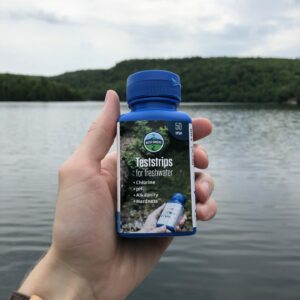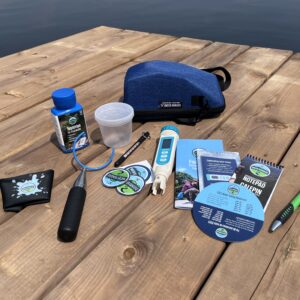Chlorine in freshwater
What is chlorine?
Chlorine, on it’s own, is a greenish-yellow, highly reactive and diatomic gas that is almost never found free in nature by itself. When found in freshwater, chlorine is most often found bonded to other elements and ions. Most chlorine is commercially produced and is most widely known for being used within compounds to purify water/ create cleaning products.

Why is chlorine important?
We use chlorine to disinfect public water supplies from pathogens, such as bacteria and viruses. To have healthy drinking water supply in cities, chlorine acts as an important part of the cleaning process. Chlorine is used in water treatment plants, our water distribution systems, in supply reservoirs, including cisterns. It follows that we sometimes find leftover traces of chlorine from water treatment in our freshwater systems including lakes, rivers, and streams. Learn more about how chlorine is used to make our water safe to drink.
Remember — all the water that comes out of your tap, as well as down your drain, comes from a water source and eventually finds its way back.
What does a chlorine measurement mean?
Chlorine helps make our water drinkable! You likely will only find small traces of chlorine in most freshwater systems.
If you read your test results and note levels of chlorine in your water, you may be near a water treatment plant, or close to someone dumping pool water. Runoff from common domestic water uses, such as watering gardens, car washing, swimming pool draining, and driveway or road flushing, can all carry chlorine some distance, and end up in our lakes, rivers, and streams.
Water Rangers testing protocol
For this test, we use Taylor Pool and Spa Test Strips. Learn why we selected this brand and our research on the accuracy of various strips.
Pro Tip: If the colour on the test strip appears in the middle of two colours on the bottle, you can record the absolute middle (for example, if the colour is somewhere between 1 and 2 record a value of 1.5).
How to test chlorine
- Rinse sample cup 3 times.
- IMPORTANT! Make sure your hands are dry, since moisture in the container will ruin strips.
- Shake out 1 test strip, close bottle.
- Dip the entire strip in the water. Remove after 2 seconds.
- Wait 20 seconds before reading.
- Compare colours with guide on side of bottle. Line up the colour strips vertically so that you can compare along the spectrum for each value.
Get chlorine test strips here or as part of a testkit:
-
 Teststrips$15.00
Teststrips$15.00 -
 Compact Freshwater Testkit$119.00
Compact Freshwater Testkit$119.00 -
 Freshwater Explorer Testkit$305.00
Freshwater Explorer Testkit$305.00
Need a more precise chlorine test?
We recommend the Hanna Checker handheld chlorine meter, available from Amazon.

Contributing to the community!
Water Rangers is citizen-scientist led. So, if you have any questions, ideas, or notice any errors, please tell us!
